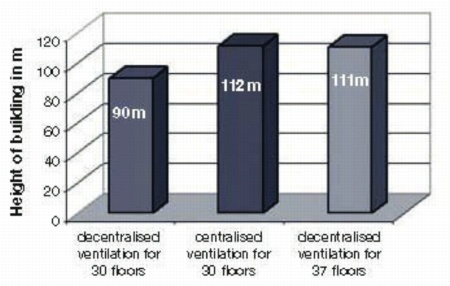A breath of fresh air

Meeting the ventilation requirements of a building from central plant needs a lot of space — both in the plant room and for ductwork to distribute the air. Barry Trewhitt looks at the cost-saving benefits of decentralised ventilation.
Thinking in the UK is so focused on the presence of a central air-handling unit (AHU) that it is hard to consider life without one. Decentralised ventilation systems, however, are becoming increasingly common across Europe. Removing the need for a central AHU and associated ductwork can reduce construction costs and complexity significantly. It also avoids ‘all-or-nothing’ capital costs by offering a ‘room-by-room’ scaleable solution.
Are UK system designers wise to be sceptical, or are we missing out on a valuable opportunity?
New builds
First, decentralised ventilation must not be confused with natural ventilation. In this article I refer to mechanical, perimeter systems (such as the Trox FSL range) designed to carry out functions such as ventilation, heating, cooling, dehumidification and/or heat recovery.
As decentralised ventilation removes the need for a false-ceiling void, the architect can reduce the height of multi-storey buildings considerably, whilst maintaining the same lettable floor area. As construction costs increase linearly with building height, the saving for an office block of 30 occupied floors, could be about 20% compared with centralised systems (see chart).
In addition, there is no need to incorporate risers, as the HVAC equipment is typically installed in fascias/perimeters. The footprint/cost for the central plant room is also reduced, and the cost of components such as fire dampers is removed.
The installation of units at the perimeter, e.g. at sill level, also provides maximum flexibility for utilisation of interior space.
For commercial buildings with multiple tenants, decentralised ventilation can be shut down in non-occupied spaces. It can also suit zones with different hours of occupation (e.g. a 24/7 call centre next to a 9-to-5 office). Building occupants also enjoy higher levels of local control.
Refurbishments
A key advantage when refurbishing is the ability to improve air quality on a room-by-room basis. At a time when budgets for centralised system projects are being withheld or withdrawn, this approach can offer a lifeline for the worst-affected parts of a building (such as a classroom, hospital ward).
In some buildings, depending on their age, decentralised ventilation may be the only feasible option for introducing ventilation and comfort cooling in buildings not designed with air conditioning in mind.
Design considerations

Before moving away from well-proven solutions, however, the designer needs to factor in the specific challenges of a decentralised approach.
There needs to be greater involvement earlier in a project with the design team, including the architect to ensure that façade-mounted units are considered from the outset.
In addition, the latest units have greater capability and functionality — delivering cooling, dehumidification, air filtration and/or heat recovery as well as heating and ventilation.
One challenge, however, is the potential for higher energy requirements to condition intake air in Summer conditions. This is assuming that the air intake for centralised systems is at roof level, compared to decentralised units installed in the façade. That potential high energy consumption could, however, be compensated by energy savings for heating in the Winter.
When considering comfort conditions for building occupants it must also be appreciated that, as the supply air discharge is typically sill mounted, the temperature of the supply air could lead to levels of discomfort for individuals sitting nearest to the units that might have very high cooling capacities.
In addition, the effects of wind pressure on the building cannot be ignored, due to the numerous decentralised ventilation openings in the façade of the building. Control systems for perimeter ventilation units also need to avoid the generation of draughts and compensate by shifting the fan operating point. And, even though fire dampers are not needed, the system designer still needs to consider the avoidance of fire transmission around the face of the building.
Finally, careful consideration needs to be given to condensation removal, maintenance and control. Removal of condensate is not so simple with decentralised units and will require an individual solution. Costs of routine maintenance would be higher as multiple units are distributed around the building. There are also challenges relating to control, as perimeter ventilation units are not usually integrated into the central building-management system.
Before dismissing decentralised ventilation however, these design challenges need to be offset against the considerable advantages already outlined.
In conclusion, whilst uncommon in the UK, the portfolio of successful decentralised ventilation projects in the rest of Europe is growing at a pace. If you are interested in exploring the potential of this approach, Trox has facilities and engineering resource to help customers investigate these issues at design stage.
Barry Trewhitt is product manager with Trox UK.








